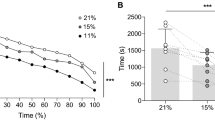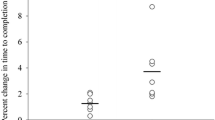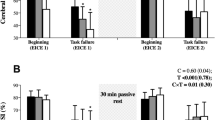Abstract
It remains uncertain as how the reduction in systemic oxygen transport limits high-intensity exercise tolerance. 11 participants (5 males; age 35 ± 10 years; peak \( {\dot{V}\text{O}}_{2} \max \) 3.5 ± 0.4 L min−1) performed cycle ergometry to the limit of tolerance: (1) a ramp test to determine ventilatory threshold (VT) and peak \( {\dot{V}\text{O}}_{2} \); (2) three to four constant-load tests in order to model the linear P–t −1 relationship for estimation of intercept (critical power; CP) and slope (AWC). All tests were performed in a random order under moderate hypoxia (FiO2 = 0.15) and normoxia. The linearity of the P–t −1 relationship was retained under hypoxia, with a systematic reduction in CP (220 ± 25 W vs. 190 ± 28 W; P < 0.01) but no significant difference in AWC (11.7 ± 5.5 kJ vs. 12.1 ± 4.4 kJ; P > 0.05). However, large individual variations in the change of the latter were observed (−36 to +66%). A significant relationship was found between the % change in CP (r = 0.80, P < 0.01) and both peak \( {\dot{V}\text{O}}_{2} \) (CP: r = −0.65, P < 0.05) and VT values recorded under normoxia (CP: r = −0.65, P < 0.05). The present study demonstrates the aerobic nature of the intercept of the P–t −1 relationship, i.e. CP. However, the extreme within-individual changes in AWC do not support the original assumption that AWC reflects a finite energy store. Lower hypoxia-induced decrements in CP were observed in aerobically fitter participants. This study also demonstrates the greater ability these participants have to exercise at supra-CP but close to CP workloads under moderate hypoxia.




Similar content being viewed by others
References
Amann M, Romer LM, Subudhi AW, Pegelow DF, Dempsey JA (2007) Severity of arterial hypoxaemia affects the relative contributions of peripheral muscle fatigue to exercise performance in healthy humans. J Physiol 581:389–403
Burnley M, Doust JH, Vanhatalo A (2006) A 3-min all-out test to determine peak oxygen uptake and the maximal steady state. Med Sci Sports Exerc 38:1995–2003
Calbet JA, Boushel R, Radegran G, Sondergaard H, Wagner PD, Saltin B (2003a) Determinants of maximal oxygen uptake in severe acute hypoxia. Am J Physiol Regul Integr Comp Physiol 284:R291–R303
Calbet JA, De Paz JA, Garatachea N, Cabeza de Vaca S, Chavarren J (2003b) Anaerobic energy provision does not limit Wingate exercise performance in endurance-trained cyclists. J Appl Physiol 94:668–676
Calbet JA, Radegran G, Boushel R, Saltin B (2009) On the mechanisms that limit oxygen uptake during exercise in acute and chronic hypoxia: role of muscle mass. J Physiol 587:477–490
Chapman RF, Emery M, Stager JM (1999) Degree of arterial desaturation in normoxia influences VO2max decline in mild hypoxia. Med Sci Sports Exerc 31:658–663
di Prampero PE (1999) The concept of critical velocity: a brief analysis. Eur J Appl Physiol Occup Physiol 80:162–164
di Prampero PE, Ferretti G (1999) The energetics of anaerobic muscle metabolism: a reappraisal of older and recent concepts. Respir Physiol 118:103–115
Ferguson C, Whipp BJ, Cathcart AJ, Rossiter HB, Turner AP, Ward SA (2007) Effects of prior very-heavy intensity exercise on indices of aerobic function and high-intensity exercise tolerance. J Appl Physiol 103:812–822
Ferguson C, Rossiter HB, Whipp BJ, Cathcart AJ, Murgatroyd SR, Ward SA (2010) Effect of recovery duration from prior exhaustive exercise on the parameters of the power–duration relationship. J Appl Physiol 108:866–874
Ferretti G, Moia C, Thomet JM, Kayser B (1997) The decrease of maximal oxygen consumption during hypoxia in man: a mirror image of the oxygen equilibrium curve. J Physiol 498(Pt 1):231–237
Fitts RH (1994) Cellular mechanisms of muscle fatigue. Physiol Rev 74:49–94
Fukuba Y, Miura A, Endo M, Kan A, Yanagawa K, Whipp BJ (2003) The curvature constant parameter of the power–duration curve for varied-power exercise. Med Sci Sports Exerc 35:1413–1418
Glantz SA (2005) How to test for trends. Primer of biostatistics. McGraw-Hill Medical, New York, pp 253–320
Hill DW (1993) The critical power concept. A review. Sports Med 16:237–254
Hogan MC, Richardson RS, Haseler LJ (1999) Human muscle performance and PCr hydrolysis with varied inspired oxygen fractions: a 31P-MRS study. J Appl Physiol 86:1367–1373
Howlett RA, Hogan MC (2007) Effect of hypoxia on fatigue development in rat muscle composed of different fibre types. Exp Physiol 92:887–894
Jenkins DG, Quigley BM (1992) Endurance training enhances critical power. Med Sci Sports Exerc 24:1283–1289
Jenkins DG, Quigley BM (1993) The influence of high-intensity exercise training on the Wlim–T lim relationship. Med Sci Sports Exerc 25:275–282
Jones AM, Wilkerson DP, DiMenna F, Fulford J, Poole DC (2008) Muscle metabolic responses to exercise above and below the critical power assessed using 31P-MRS. Am J Physiol Regul Integr Comp Physiol 294:R585–R593
Miura A, Kino F, Kajitani S, Sato H, Fukuba Y (1999) The effect of oral creatine supplementation on the curvature constant parameter of the power–duration curve for cycle ergometry in humans. Jpn J Physiol 49:169–174
Miura A, Sato H, Sato H, Whipp BJ, Fukuba Y (2000) The effect of glycogen depletion on the curvature constant parameter of the power–duration curve for cycle ergometry. Ergonomics 43:133–141
Monod H, Scherrer J (1965) The work capacity of a synergic muscular group. Ergonomics 8:329–338
Moritani T, Nagata A, deVries HA, Muro M (1981) Critical power as a measure of physical work capacity and anaerobic threshold. Ergonomics 24:339–350
Morton RH, Hodgson DJ (1996) The relationship between power output and endurance: a brief review. Eur J Appl Physiol Occup Physiol 73:491–502
Peltonen JE, Tikkanen HO, Rusko HK (2001) Cardiorespiratory responses to exercise in acute hypoxia, hyperoxia and normoxia. Eur J Appl Physiol 85:82–88
Ponsot E, Dufour SP, Doutreleau S, Lonsdorfer-Wolf E, Lampert E, Piquard F, Geny B, Mettauer B, Ventura-Clapier R, Richard R (2010) Impairment of maximal aerobic power with moderate hypoxia in endurance athletes: do skeletal muscle mitochondria play a role? Am J Physiol Regul Integr Comp Physiol 298:R558–R566
Poole DC, Ward SA, Gardner GW, Whipp BJ (1988) Metabolic and respiratory profile of the upper limit for prolonged exercise in man. Ergonomics 31:1265–1279
Richardson RS, Noyszewski EA, Leigh JS, Wagner PD (1998) Lactate efflux from exercising human skeletal muscle: role of intracellular PO2. J Appl Physiol 85:627–634
Richardson RS, Grassi B, Gavin TP, Haseler LJ, Tagore K, Roca J, Wagner PD (1999a) Evidence of O2 supply dependent VO2 max in the exercise-trained human quadriceps. J Appl Physiol 86:1048–1053
Richardson RS, Leigh JS, Wagner PD, Noyszewski EA (1999b) Cellular PO2 as a determinant of maximal mitochondrial O2 consumption in trained human skeletal muscle. J Appl Physiol 87:325–331
Robergs RA, Ghiasvand F, Parker D (2004) Biochemistry of exercise-induced metabolic acidosis. Am J Physiol Regul Integr Comp Physiol 287:R502–R516
Romer LM, Dempsey JA (2006) Effects of exercise-induced arterial hypoxaemia on limb muscle fatigue and performance. Clin Exp Pharmacol Physiol 33:391–394
Romer LM, Haverkamp HC, Amann M, Lovering AT, Pegelow DF, Dempsey JA (2007) Effect of acute severe hypoxia on peripheral fatigue and endurance capacity in healthy humans. Am J Physiol Regul Integr Comp Physiol 292:R598–R606
Vanhatalo A, Fulford J, DiMenna FJ, Jones AM (2010) Influence of hyperoxia on muscle metabolic responses and the power–duration relationship during severe-intensity exercise in humans: a 31P magnetic resonance spectroscopy study. Exp Physiol 95:528–540
Wasserman K, Whipp BJ, Koyl SN, Beaver WL (1973) Anaerobic threshold and respiratory gas exchange during exercise. J Appl Physiol 35:236–243
Westerblad H, Allen DG (2003) Cellular mechanisms of skeletal muscle fatigue. Advances in experimental medicine and biology 538:563–570
Weyand PG, Lee CS, Martinez-Ruiz R, Bundle MW, Bellizzi MJ, Wright S (1999) High-speed running performance is largely unaffected by hypoxic reductions in aerobic power. J Appl Physiol 86:2059–2064
Conflict of interest
None.
Author information
Authors and Affiliations
Corresponding author
Additional information
Communicated by Guido Ferretti.
Rights and permissions
About this article
Cite this article
Dekerle, J., Mucci, P. & Carter, H. Influence of moderate hypoxia on tolerance to high-intensity exercise. Eur J Appl Physiol 112, 327–335 (2012). https://doi.org/10.1007/s00421-011-1979-z
Received:
Accepted:
Published:
Issue Date:
DOI: https://doi.org/10.1007/s00421-011-1979-z




